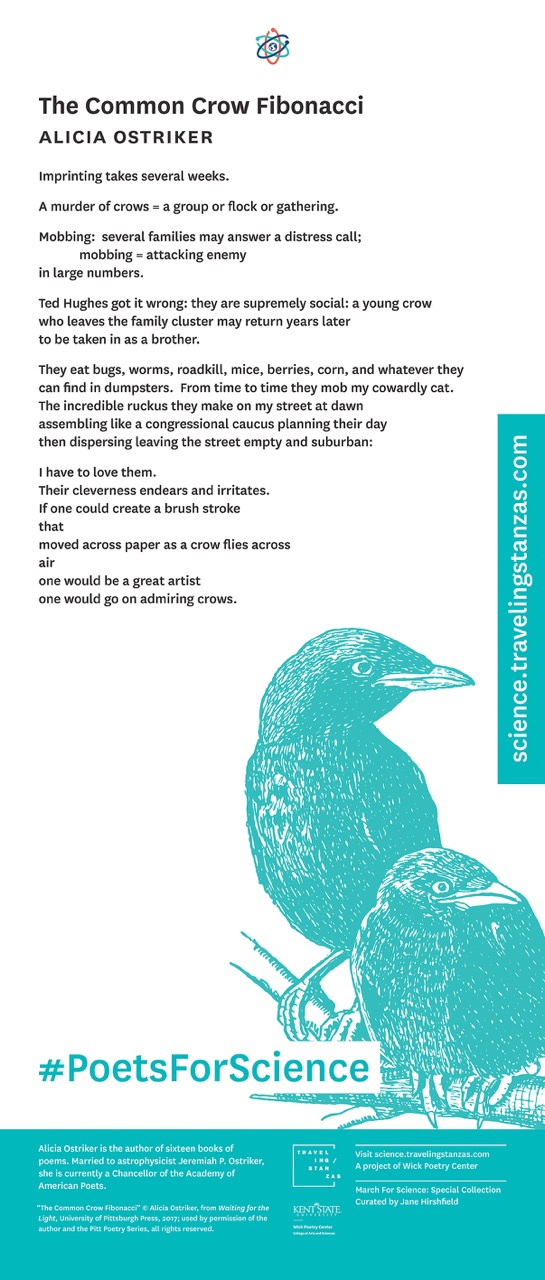
Not only is April host to Earth Day, but it also National Poetry Month here in the US. Those two events intersected yesterday in a program that Academy of American Poets Chancellor Jane Hirshfield developed called “Poets for Science.”
Hirshfield is one of the most accomplished contemporary American poets, and environmental awareness has long been a major theme of her work. The entry about her in The Dictionary of Literary Biography states that “Hirshfield’s work recognizes the full breadth and responsibilities of humans’ transactions with the earth, not just the intimacies.” Hirshfield had become increasingly concerned about the current administration’s approach to the environment, including the decision to excise any mention of climate change from the current EPA website. Therefore, when she hear about the March for Science on the National Mall in Washington DC on April 22, she wanted poetry to be a part of the pro-science protest.
Working with the Wick Poetry Center at Kent State University, Hirshfield curated a collection of poems that dealt with science, math, and other related topics. The Wick Center arranged to have them designed into posters that could be used by protesters at the national March for Science as well as for the numerous local gatherings. Below is a sample from one of my favorites from the collection, “The Common Crow Fibonacci” by another Chancellor of the Academy of American Poet, Alicia Ostriker:

Hirshfield also wrote a special poem for the March for Science, which she read aloud at the event. That poem is “On the Fifth Day”:
On the fifth day
the scientists who studied the rivers
were forbidden to speak
or to study the rivers.
The scientists who studied the air
were told not to speak of the air,
and the ones who worked for the farmers
were silenced,
and the ones who worked for the bees.Someone, from deep in the Badlands,
began posting facts.
The facts were told not to speak
and were taken away.
The facts, surprised to be taken, were silent.Now it was only the rivers
that spoke of the rivers,
and only the wind that spoke of its bees,
while the unpausing factual buds of the fruit trees
continued to move toward their fruit.The silence spoke loudly of silence,
and the rivers kept speaking,
of rivers, of boulders and air.
Bound to gravity, earless and tongueless,
the untested rivers kept speaking.Bus drivers, shelf stockers,
code writers, machinists, accountants,
lab techs, cellists kept speaking.
They spoke, the fifth day,
of silence.– Jane Hirshfield
National Poetry Month is always a big deal in my literature class. But I love that poets like Hirshfield are out demonstrating the importance and relevancy of poetry to our everyday lives.
The March on Washington is over, but at the website, they are holding a “Week of Action” to move beyond protest and into changing opinions and policies. You can check that out here.
If you would like to read all the Poets for Science, you can find the entire collection here. (Or stay tuned to this blog, because I plan to put up a few more of my favorites in later posts.)
If you would like to become a Poet for Science, you can create your own found word poem, based on the texts from the major speakers from the March for Science, and share it here.

I learn so much by reading your blogs! Thank you!!!
LikeLiked by 1 person
Thank you! I’m glad to spread the word about the good things other people are doing.
LikeLike
Such a big, deep conversation happening these days… Sometimes I feel it’s too complex for mere words. Poetry is more layered, though, so it can capture some types of complexity at the depth comparable to formulas. Especially emotional and relational complexities.
There were a lot of Science March slogans at the National Math Festival (only a mile away, same day). Also, the Bridges Math Art exhibit was there. A convergence of value-aligned activities in time and space.
Thank you for the update!
LikeLike